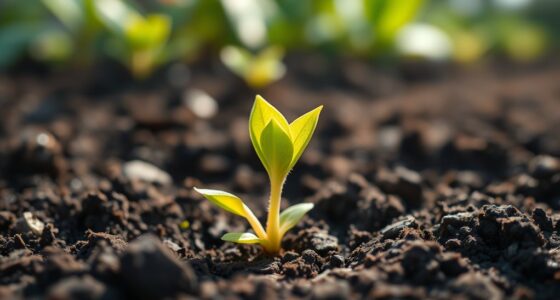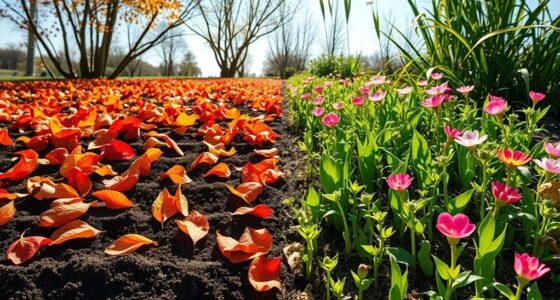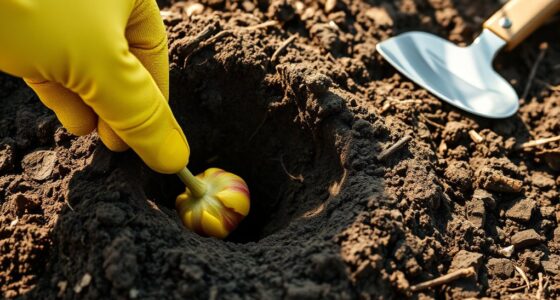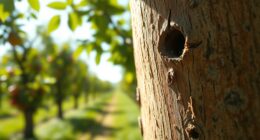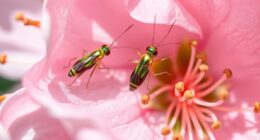To propagate plumeria, you can use cuttings, seeds, or grafting. For cuttings, choose a healthy stem, let it dry for a few days, then plant in well-draining soil and water sparingly. Growing from seeds involves planting them in moist, well-draining soil and keeping them warm in bright, indirect light until they germinate. Grafting requires selecting compatible rootstocks and carefully attaching the scion during active growth. Keep exploring to discover detailed techniques for each method.
Key Takeaways
- Propagate plumeria from healthy cuttings, allowing them to callus before planting in well-draining soil.
- Grow from seeds by planting shallowly in moist, well-draining soil and providing warm, indirect sunlight.
- Use grafting techniques during active growth, securing the scion to rootstock with tape for successful union.
- Maintain proper soil conditions, watering sparingly at first, then gradually increasing to promote healthy root development.
- Ensure optimal growing conditions like warmth, bright indirect light, and proper care to maximize propagation success.
Propagating Plumeria From Cuttings

Propagating plumeria from cuttings is a straightforward and effective method to grow new plants. To start, choose a healthy, mature stem and let it dry for a few days to form a callus, which helps prevent rot. When preparing the soil, use well-draining soil mixed with sand or perlite to ensure proper drainage. Proper soil preparation minimizes the risk of waterlogged roots. After planting your cutting, set a consistent watering schedule—water sparingly at first, allowing the soil to dry out between waterings. Overwatering can cause rot, while underwatering may hinder growth. As the roots develop, you can gradually increase watering frequency. Keep the soil moist but not soaked, and place the cutting in a warm, bright location to encourage healthy growth. Favorable growing conditions further support successful propagation and thriving plants.
Growing Plumeria From Seeds
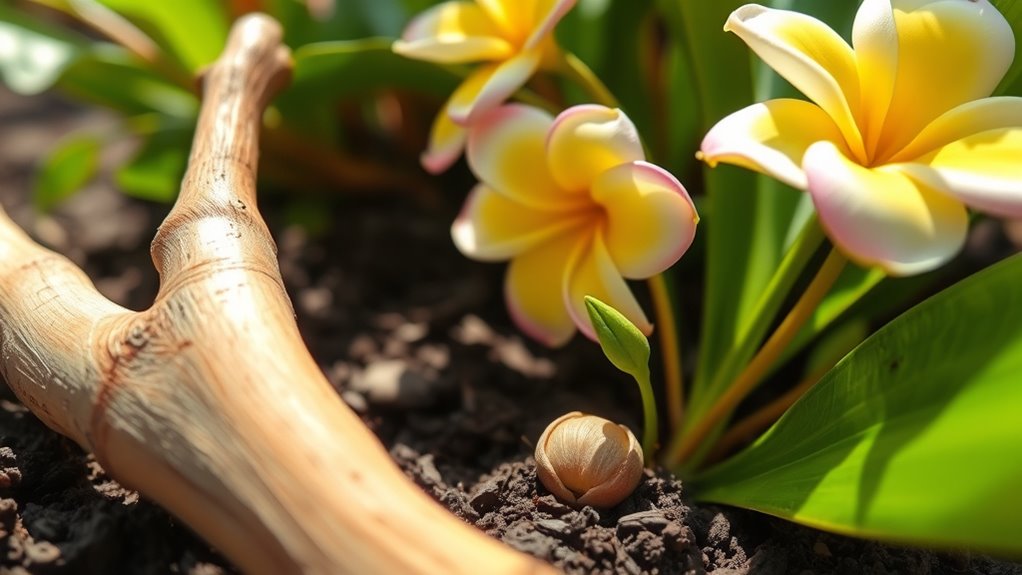
Growing plumeria from seeds is an exciting way to expand your garden and introduce new varieties. Start by preparing the soil with good drainage, mixing in organic matter like compost to boost nutrients. Use a shallow container with drainage holes, filling it with this well-draining soil. Plant the seeds about half an inch deep, spacing them adequately. Keep the soil moist but not waterlogged, following a consistent watering schedule—watering when the top inch feels dry. Keep the container in a warm, bright location with indirect sunlight. Germination can take several weeks, so patience is key. Once seedlings develop a few inches of growth, you can transplant them into larger pots or your garden, ensuring they continue to receive proper watering and sunlight. Proper seedling care will help ensure healthy growth and successful propagation. Providing the right growing conditions is essential for thriving plumeria from seeds.
Grafting Techniques for Plumeria

Grafting is a highly effective method for propagating plumeria, allowing you to combine the desirable traits of different varieties and produce vigorous, disease-resistant plants. To succeed, you need to carefully select the right rootstock, typically a healthy, compatible plumeria with strong growth. Proper rootstock selection ensures better graft success and plant vigor. Grafting timing is vital—perform the procedure during the plant’s active growth phase, usually in spring or early summer, when the sap is flowing freely. Use a sharp, sterilized knife to make clean cuts on both the rootstock and scion. Secure the graft with grafting tape or rubber bands, ensuring good contact between the cambium layers. Proper timing and rootstock selection considerably increase your chances of a successful graft. Additionally, understanding the grafting techniques can further improve your success rate and ensure healthy development of your plumeria. Ensuring proper technique application can significantly influence the overall health and longevity of the grafted plant. Selecting the appropriate grafting method tailored to your specific needs can optimize results and plant vitality.
Frequently Asked Questions
What Is the Best Time of Year to Propagate Plumeria?
You should consider seasonal considerations and choose the most suitable timing for propagating your plumeria. The best time is during spring or early summer when the weather warms up, and the plant is actively growing. This period offers ideal conditions for roots to develop quickly. Avoid propagating in winter or colder months, as low temperatures hinder growth. Timing your propagation properly ensures healthier, more successful plants.
How Long Does It Take for Cuttings to Root?
While patience is a virtue, understanding rooting time helps you plan better. Typically, plumeria cuttings take about 4 to 8 weeks to establish roots, though this varies with temperature management. Keep the environment warm and consistent, around 70-85°F, to encourage faster rooting. Proper care and stable conditions allow your cuttings to develop strong roots, setting the stage for healthy growth and vibrant blooms.
Can Plumeria Be Propagated Indoors Successfully?
Yes, you can propagate plumeria indoors successfully. Make sure you place it in bright indoor lighting, like near a south-facing window, to mimic sunlight. Choose a well-draining container with drainage holes to prevent overwatering. Keep the soil slightly moist and maintain warm temperatures. With proper lighting and container selection, your indoor plumeria can thrive and grow beautifully.
What Are Common Pests Affecting Propagating Plumeria?
When propagating plumeria, pests like spider mites, mealybugs, and aphids can cause trouble. To prevent infestations, practice pest prevention by regularly inspecting your plants and removing affected areas. Use organic treatments such as neem oil or insecticidal soap to control pests without chemicals. Keeping your propagating area clean and ensuring proper airflow also helps reduce pest issues, giving your plumeria a healthy start.
How Do I Ensure Successful Grafting of Plumeria Varieties?
Think of successful grafting as forging a lasting bond between two souls. To guarantee it, you focus on graft compatibility; choose compatible varieties with similar growth habits. Use precise grafting techniques, like clean cuts and proper alignment, to promote healing. Keep the grafted plant in a warm, humid environment, and avoid stress. With patience and care, your plumeria will flourish, symbolizing unity and growth through skilled grafting.
Conclusion
No matter which method you choose—cuttings, seeds, or grafting—propagating plumeria is like planting a seed of future beauty. With patience and care, you’ll watch your new plants grow strong and vibrant, turning your garden into a colorful tapestry. Think of each technique as a different brushstroke on your masterpiece; together, they create a stunning display of nature’s artistry that will bloom for years to come.


